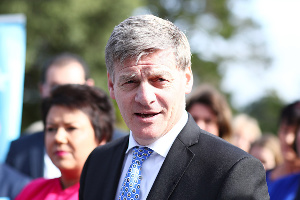
Although it is incredibly difficult to pick the timing of future rate cuts, the bank’s best guess is February next year.
Kiwibank chief economist Jarrod Kerr believes wholesale rates, and all lending rates, including mortgage rates have peaked.
“That is an important message for Kiwi households and businesses. Interest rates are likely to fall from here,” he says. “If the economy develops in a way we expect, then the RBNZ will start easing early next year.”
Kerr says financial markets are already beginning to price in the bank’s long-held view. “The RBNZ has reached a pivot point and peak in the cash rate. Since 2021, it has been hell bent on dragging inflation back down to 2%. “It has yet to achieve this, but it has done enough,” he says.
The RBNZ lowered its forecast OCR track from the end of 2024, well below market pricing. All lines have moved closer to Kiwibank’s forecast track, which remains unchanged, with market expectations for the cash rate falling.
Wholesale interest rates have dropped. They feed into lower deposit and lending rates and Kerr says, if the bank’s economists are correct, all interest rates will start declining into 2024 and beyond. “The strong headwind that is rising interest rates, will turn into a tailwind later this year,” he says.
“Interest rates tell you everything you need to know. And the interest rate curves are deeply inverted. This is a warning sign, with a nine-to-12-month lead time,” he says. The Kiwi curve inverted in July last year and the country has recorded a recession already.
Expectations of the next move in interest rates are lower, he says. For example, the two-year swap rate in one year’s time is 4.55%, 80bps below the existing two-year rate of 5.35%.
Kiwibank’s central scenario sees a steady decline in the pivotal two-year swap rate from about 5.25% to 4.7% by the end of the year. The fall continues to 3.75% by year-end 2024, before hitting 3% by year-end 2025.
“That’s a meaningful move to neutral,” Kerr says. And mortgage and business lending rates will head lower. This time next year, Kerr expects the one and two-year fixed mortgage rates will regain their favoured status as the most attractive options.
Offered rates could fall from today’s 6-7% range, back into the 5-6% range this time next year, with further downward moves into 2025.
“As we have said, tailwinds are coming.”
It’s all about inflation
Kerr says there are obviously risks to both sides of its forecast – immigration and Government spending on cyclone repairs.
Homegrown inflation is concerning the RBNZ. Inflation is only forecast to fall below 3%, late next year. “It’s still a long journey back to the 2% target. The good news is, we’re on the way.”
The forecast slowdown will drive a loosening in the labour market, Kerr says. “Add to that the migrant-led increase in labour supply, at a time when demand is turning south. We may see the unemployment rate rising to 5-5.5% next year. As the labour market loosens, its inflationary impulse will soften.
“If the downside risks dominate, then rate cuts will come sooner”, he says. “We are already below market consensus, but we could easily see more downside risks developing, requiring an even more aggressive easing cycle.”
There is a risk, Kerr says, that the RBNZ will be forced to ease rates by year-end, possibly in November. And The OCR is at least 250bps above neutral. In other words, at 5.5%, the cash rate would need to be slashed through the 2-3% neutral range to become stimulatory.
“If the RBNZ must provide stimulus, then we could see +400bps of easing. Under the downside scenario, we would see a much faster fall in short-term rates, steepening the Kiwi curve,” he says.
Lending and deposit rates would drop swiftly, and the Kiwi currency would fall faster. “Our point here is that the risks to interest rates, and the currency, are asymmetric”, Kerr says.



